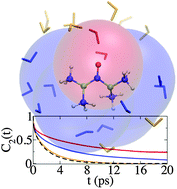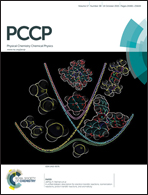On the slowdown mechanism of water dynamics around small amphiphiles†
Abstract
Aqueous solvation of small amphiphilic molecules exhibits a unique and complex dynamics, that is only partially understood. A recent series of studies on the hydration of small organic compounds, such as tetramethylurea (TMU), trimethylamine N-oxide (TMAO) and urea, has provided strong evidence of a slowdown of the dynamics of the hydrating water molecules. However, the mechanism of this slowdown is still a matter of debate. We analyze the slowdown mechanism by combining molecular dynamics (MD) simulations, using ab initio and classical force field methods, with mid-infrared pump–probe spectroscopy. Aqueous solutions of TMU and of urea were studied at a 0.1 solute/solvent ratio, where we decompose the contribution of different solvating groups to the orientational dynamics. Our results reveal that two competing processes govern the H-bond breaking mechanism: H-bond switching through an associative partner exchange and a dissociative breaking characterized by an unbound state. H-bond switches are shown to occur less often near hydrophobic groups, thus creating a subset of OH groups that do not switch and therefore do not significantly reorient within the lifetime of one H-bond, but will require at least a second H-bond to be formed and broken before it may switch. Our results shed new light on the role of hydrophobic solvation in the water orientational dynamics and help to conciliate the controversy regarding the timescale separation, providing a mechanistic explanation for the observed slow component.


 Please wait while we load your content...
Please wait while we load your content...